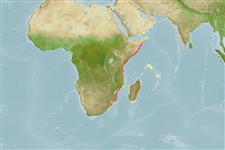Classification / Names
Noms communs | Synonymes | Catalog of Fishes(Genre, Espèce) | ITIS | CoL | WoRMS | Cloffa
>
Mulliformes (Goatfishes) >
Mullidae (Goatfishes)
Etymology: Parupeneus: Latin, parum, parvum = small + Peneus, the name of a river; nansen: Named for the research vessel Dr. Fridtjof Nansen; noun in apposition..
More on authors: Randall & Heemstra.
Environment: milieu / climate zone / depth range / distribution range
Écologie
marin récifal; profondeur 36 - 51 m (Ref. 82838). Tropical
Western Indian Ocean: Mozambique and probably Somalia.
Taille / Poids / Âge
Maturity: Lm ? range ? - ? cm
Max length : 13.9 cm SL mâle / non sexé; (Ref. 82838); 11.4 cm SL (female)
Description synthétique
Morphologie | Morphométrie
Épines dorsales (Total): 8; Rayons mous dorsaux (Total): 9; Rayons mous anaux: 7; Vertèbres: 24. This species is distinguished by the following characters: 15 or 16 pectoral-fin rays; 6 or 7 + 21-23 gill rakers; moderately elongate body, depth 3.6-3.85 in SL; head length 2.85-2.95 in SL; interorbital space flat medially; snout length 1.9-2.05 in HL; interorbital space flat medially; maxilla symmetrically rounded posteriorly; depth of maxilla 5.05-5.3 in HL; barbel length 1.35-1.45 in HL; longest dorsal spine 1.85-2.0 in HL; pectoral fins 1.35-1.4 in HL; pelvic fins 1.5-1.6 in HL. Color in alcohol pale tan, scale edges a little darker; a faint orangish brown stripe following lateral line; no dark spot on eighth lateral-line scale; fins are translucent pale yellowish; when fresh light yellowish grey dorsally, the scale edges narrowly red, grading to silvery grey below, the red edges of scales progressively fainter ventrally; head broadly red dorsally, grading to silvery white on cheek and operculum; white barbels; three large deep pink to red spots on caudal fin, one in each lobe and one at midbase of fin (Ref. 82838).
Life cycle and mating behavior
Maturité | Reproduction | Frai | Œufs | Fécondité | Larves
Randall, J.E. and E. Heemstra, 2009. Three new goatfishes of the genus Parupeneus from the Western Indian Ocean, with resurrection of P. seychellensis. Smithiana Bulletin 10:37-50. (Ref. 82838)
Statut dans la liste rouge de l'IUCN (Ref. 130435)
Menace pour l'homme
Harmless
Utilisations par l'homme
Plus d'informations
PaysZones FAOÉcosystèmesOccurrencesIntroductionsStocksÉcologieRégime alimentaireÉléments du régime alimentaireConsommation alimentaireRation
Noms communsSynonymesMétabolismePrédateursÉcotoxicologieReproductionMaturitéFraiRassemblement de ponteFéconditéŒufsDéveloppement de l'œuf
Taille/ÂgeCroissanceLongueur-poidsLongueur-longueurFréquences de longueursMorphométrieMorphologieLarvesDynamique des populations larvairesRecrutementAbondanceBRUVS
RéférencesAquacultureProfil d'aquacultureSouchesGénétiqueElectrophoresesHéritabilitéPathologiesTraitementNutrientsMass conversion
CollaborateursImagesStamps, Coins Misc.SonsCiguateraVitesseType de nageSurface branchialeOtolithesCerveauxVision
Outils
Articles particuliers
Télécharger en XML
Sources Internet
Estimates based on models
Preferred temperature (Ref.
123201): 25.3 - 27.6, mean 26.1 °C (based on 9 cells).
Phylogenetic diversity index (Ref.
82804): PD
50 = 0.5000 [Uniqueness, from 0.5 = low to 2.0 = high].
Bayesian length-weight: a=0.01202 (0.00556 - 0.02601), b=3.10 (2.93 - 3.27), in cm total length, based on LWR estimates for this Genus-body shape (Ref.
93245).
Niveau trophique (Ref.
69278): 3.4 ±0.4 se; based on size and trophs of closest relatives
Résilience (Ref.
120179): Haut, temps minimum de doublement de population inférieur à 15 mois (Preliminary K or Fecundity.).
Fishing Vulnerability (Ref.
59153): Low vulnerability (10 of 100).
